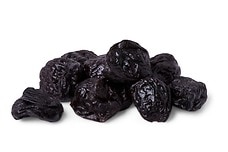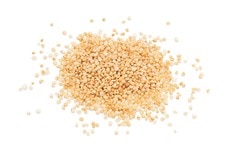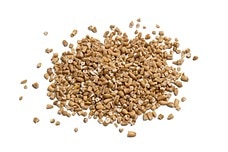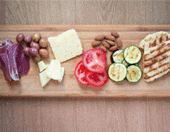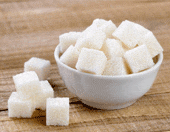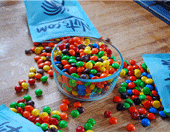A Comprehensive Guide to the Glycemic Index
Blood sugar levels refer to the amount of glucose circulating through the body. Our cells rely on glucose for energy. However, some people develop problems regulating their body’s glucose levels. This can have major health consequences, making it important to monitor the effect of dietary choices on blood glucose.
What Is the Glycemic Index?
The glycemic index is used to measure how much a food increases a person’s blood glucose. The glycemic index is used specifically for foods that contain carbohydrates. This is because carbohydrates are long molecules that can be broken down into glucose. Some simple carbohydrates are very easily broken down, while other complex carbohydrates are more difficult such that their metabolism requires longer periods of time (Harvard T.H. Chan School of Public Health, n.d.).
The glycemic index compares a given food to a reference food, usually white bread or pure glucose. For example, a food with a GI of 55 means that it causes blood sugar to be 55% as high as it would have been had you eaten pure glucose. Foods with a high GI tend to raise blood glucose levels more than foods with low GI. Choosing foods based on GI may be useful for people trying to regulate their blood sugar levels.
Purpose of Eating Low Glycemic Index Foods

After you eat carbohydrate-containing foods, your digestive system breaks the carbohydrate molecules into sugar. This causes blood sugar levels to rise, triggering the pancreas to release the hormone insulin (Harvard T.H. Chan School of Public Health, n.d.). Insulin tells your cells to absorb blood glucose for later use.
In healthy individuals, this system works effectively to keep blood sugar levels within a certain limit. For people with type 2 diabetes, however, cells become resistant to insulin. Thus, diabetics cannot naturally control their blood sugar levels. Eating low glycemic index foods is a good way for people with diabetes to regulate their blood sugar. Avoiding high GI foods, which cause glucose levels to spike, helps to keep blood sugar within a healthy range. Of course, eating low GI foods is a healthy choice for anyone, not just those afflicted by diabetes.
Glycemic Index of Common Foods
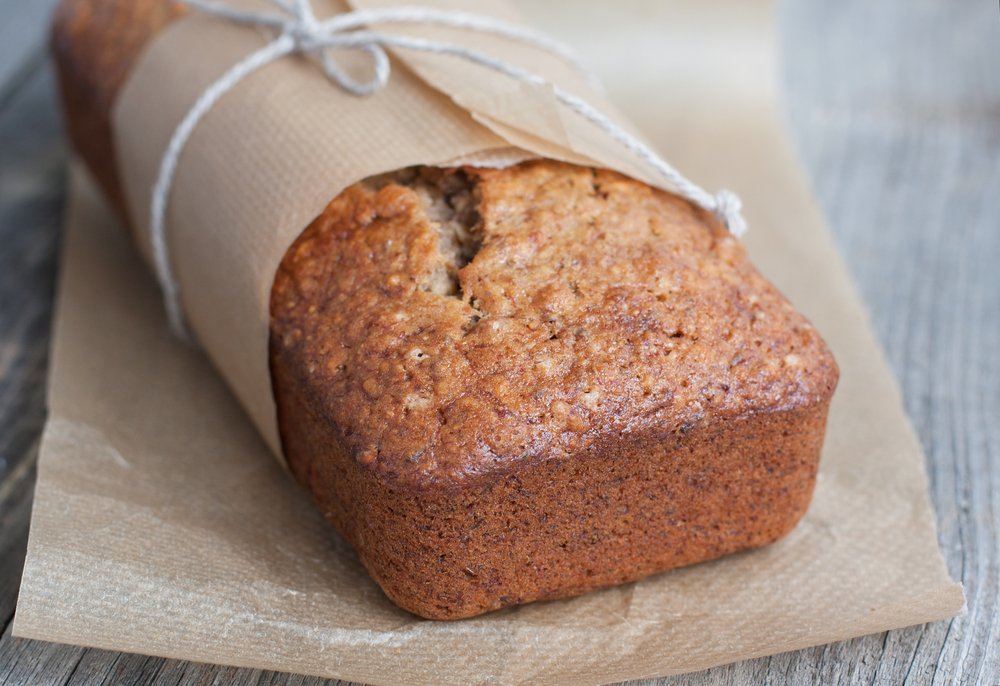
Typically, the presence of fat or fiber tends to lower the GI of a food. In fact, eating foods rich in dietary fiber may protect against blood sugar fluctuations (Joslin Diabetes Center, n.d.). A good rule of thumb is to focus on eating plenty of whole fruits, vegetables, and whole grains. Foods that are highly processed, on the other hand, are more likely to be high glycemic index foods. Keep in mind that the GI of fruits and vegetables increases as they ripen.
A high glycemic index is typically considered greater than 70. Foods with GI between 56 and 69 are considered medium GI, while foods below 55 are low GI (American Diabetes Association, 2014). Consider the following foods (Harvard Medical School, 2015):
High GI Foods:
- White rice: GI of 89
- Whole wheat bread: 71
- White bagel: 72
- Gatorade: 78
- Instant oatmeal: 83
- Watermelon: 72
- Baked potato: 111
- Cheese pizza: 80
Medium GI Foods:
- White pita bread: 68
- Coca Cola: 63
- Raisin bran: 61
- Couscous: 65
- Regular ice cream: 57
- Banana: 62
- Grapes: 59
- Kraft macaroni and cheese: 64
Low GI Foods:
- 100% whole grain bread: 51
- Apple juice (unsweetened): 44
- Rolled oats: 55
- Quinoa: 53
- Brown rice: 50
- Nonfat milk: 32
- Apple: 39
- Prunes: 29
- Chickpeas: 10
- Cashews: 27
- Peanuts: 7
Following a Glycemic Index Diet
When using glycemic index to make dietary choices, it is best to limit consumption of high GI foods. Fortunately, many low GI foods such as fruits and vegetables are also high in dietary fiber. Dietary fiber increases feelings of satiety, helping you feel full for a longer period of time. This can prevent overeating, which might cause a spike in blood sugar levels even when the foods being consumed have a low GI value.
It is not always clear how much of a low GI food one can consume without it affecting their blood glucose levels more than a small amount of a high GI food would have. There are certain seemingly healthful foods, for example, that have a surprisingly high GI value: bananas, watermelon and pineapple each have a GI value greater than 60. However, eating a serving of watermelon may not carry as large of an effect on your blood sugar levels as eating a donut, despite the fact that each has the same GI value (Higdon, Drake, Delage & Liu, 2016).
The Combination Effect
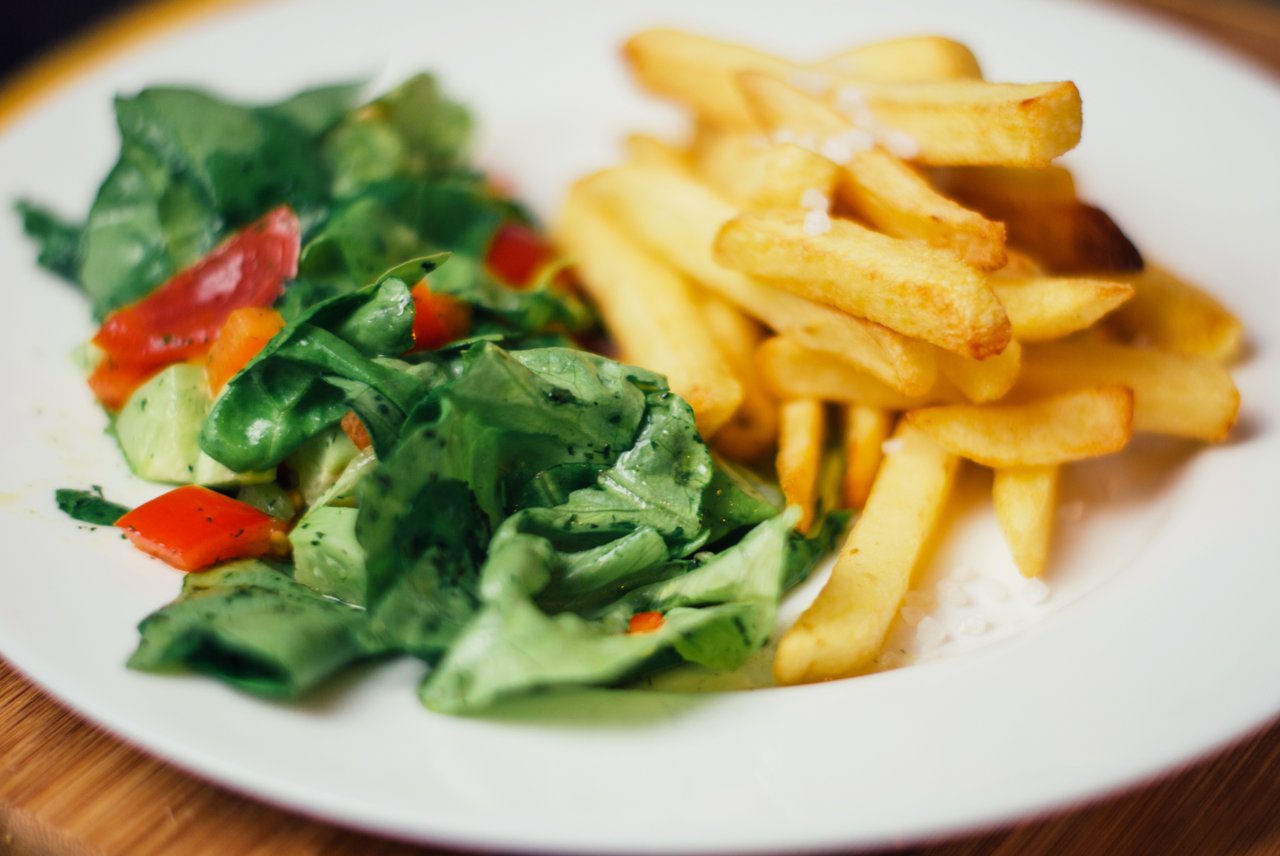
Another way to approach working high GI foods into your eating routine is to combine them with protein, fats, and/or low GI foods (E.g. quinoa and cashews). For example, instead of just eating a banana, which is a high GI food; combine the banana with low GI foods like quinoa and cashews to help balance blood sugar levels.
Glycemic Load: A Smarter Way to Eat?
One way to expand the scope of the information provided by the glycemic index is to make use of a metric known as a food’s “glycemic load.” The glycemic load is a figure obtained by multiplying the grams of digestible carbohydrates contained in one serving of a food by its GI value and then dividing this value by 100.
Because the resulting value is indicative of both the effects of a specific food’s carbohydrates on blood sugar levels and the amount of carbohydrates that the food contains, the glycemic load of a food may serve as a more clear indication of its impact on your blood glucose levels. Foods with a GL of 11 to 19 are considered to have a medium glycemic load; foods with a medium or low glycemic load include:
- Wheat tortillas (low)
- Skim milk (low)
- Cashews (low)
- Black beans (low)
- Doughnut (medium)
- Watermelon (low)
- Boiled brown rice (high)
- White-Wheat Flour Bread (low)
- Honey (low)
- Whole grain pumpernickel bread (low)
Several studies show that lower GL diets were associated with lower risk for developing type 2 diabetes and that higher GL diets were associated with increased risk for cardiovascular disease.
Recipes with Low GI Foods
The following recipes utilize primarily foods with a relatively low GI and balances its ingredients to offer a conservative glycemic load. Each recipe is also formulated to include good sources of fiber and protein, as well as a number of essential vitamins and minerals. For more foods that keep your blood sugar levels in mind, check out our article on dietary considerations for diabetics.
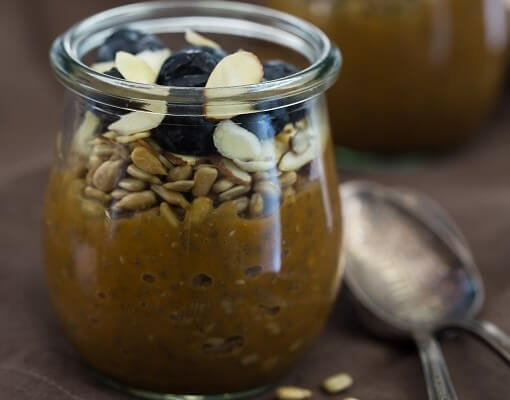
Pumpkin Chia Seed Pudding Recipe
This pumpkin chia seed pudding is a delicious way to start your day and achieves a sweet savor with the low GI foods of maple syrup and milk. The seeds, nuts, and pumpkin provide a source of protein, fiber, vitamins, and minerals.
Ingredients: Milk, pumpkin puree, chia seeds, maple syrup, pumpkin spice, sunflower seeds, sliced almonds, fresh blueberries.
Total Time: 10 minutes
| Yield: 4 servings
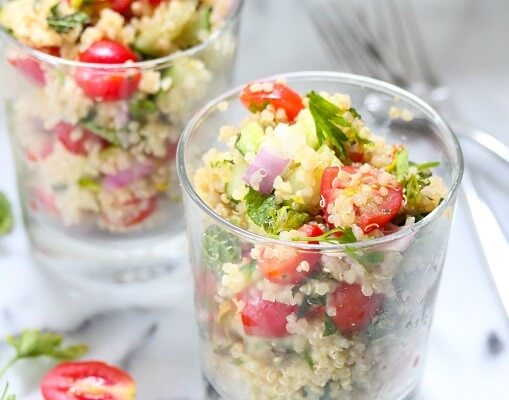
Quinoa Tabbouleh Salad Recipe {gluten-free}
This simple salad takes a Mediterranean dish and adds a slight twist by including to low GI, quinoa. Not only does this pseudograin supply protein and fiber but it also has a low glycemic load, meaning that it gives you much needed energy without causing extreme highs and lows in your blood sugar level.
Ingredients: Quinoa, cherry tomatoes, red onion, cucumber, extra virgin olive oil, balsamic vinegar, fresh parsley, fresh mint, black pepper, salt.
Total Time: 40 minutes
| Yield: 4 servings
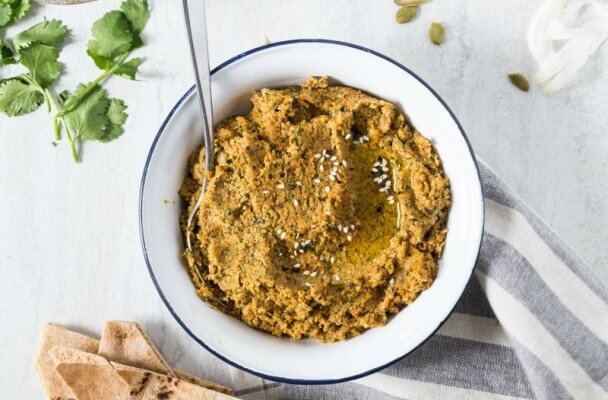
Pumpkin Seed Salsa Recipe
A scrumptious salsa that can be added to your favorite low GI energy source to improve the taste of a simple whole grain bread, this blend of pumpkin seeds and spices supplies a delectable flavor and appealing texture that offers 6 grams of protein per serving.
Ingredients: Pumpkin seeds, tomatoes, garlic, cayenne pepper, olive oil, cilantro, salt.
Total Time: 10 minutes
| Yield: 12 servings
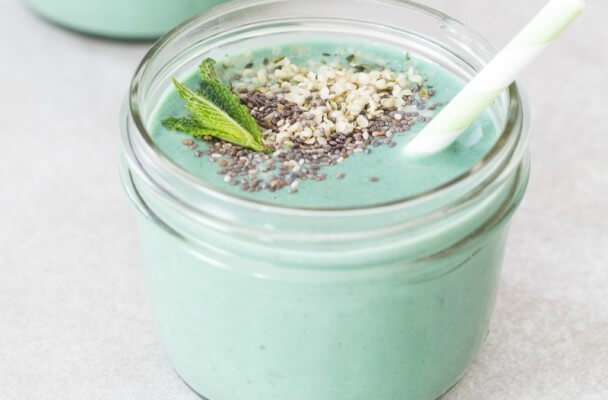
Protein-Packed Detox Smoothie Recipe {vegan}
This smoothie can quell your hunger and help you meet your nutritional needs without sending your blood sugar levels through the roof. Each smoothie contains less than 7 grams of sugar and contains mostly low GI powders, fruits and veggies while supplying 19 grams of protein and 10 grams of fiber.
Ingredients: Almond milk, frozen banana, spirulina, hemp protein powder (optional), fresh mint, chia seeds, hemp hearts.
Total Time: 5 minutes
| Yield: 2 servings
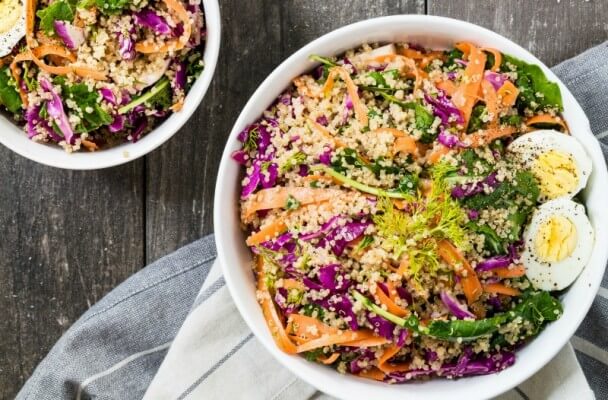
Kale Quinoa Salad Recipe
This simple salad combines low GI foods like quinoa, kale, cabbage, and carrots to offer a filling meal that supplies a steady stream of energy. The salad also offers a variety of essential nutrients from its combination of superfoods quinoa and kale as well as its inclusion of a hardboiled egg, which offers vitamin B12, selenium and iodine.
Ingredients: Quinoa, fresh baby kale, purple cabbage, carrots, fresh dill, boiled eggs, rice wine, extra virgin olive oil, black pepper.
Total Time: 25 minutes
| Yield: 8 servings
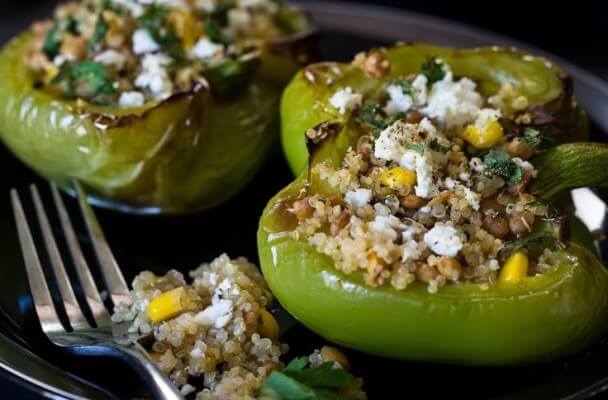
Quinoa Stuffed Peppers Recipe {gluten-free}
Cheeses are often missed by diets focused on mitigating the risks of blood sugar level spikes; but, not only does feta cheese feature a surprisingly low glycemic load, but it also is included in moderation in this dish to supply a full flavor that doesn’t define the dish. The plate itself is superbly scrumptious with a blend of low GI veggies, grains and legumes.
Ingredients: Quinoa, green bell peppers, canned lentils, fresh spinach, feta cheese, frozen corn (thawed), salt, black pepper.
Total Time: 40 minutes
| Yield: 6 servings (8 half-peppers)
Low GI Snacks
The following foods are great ways to keep the glycemic load of your foods in check. Add these delectable snacks and foods to your diet today, and find more diabetic friendly foods on our diabetes and diabetic diet pages!
Healthy Eating
- Healthy Snacks
- Healthy Highlights
- 5 Uses for Cacao Powder
- 5 Ways to Eat Farro
- 6 Best Gluten-Free Foods
- Alcohol and the Body
- Almond Flour Recipes
- Anti-Aging Superfoods
- Beat the Afternoon Slump
- Benefits of a Plant-Based Diet
- Benefits of Baobab
- Benefits of Cashews
- Benefits of Coconut Oil for Hair
- Benefits of Coconuts
- Benefits of Dates
- Benefits of Fenugreek
- Benefits of Garcinia Cambogia
- Benefits of Goji Berries
- Benefits of Kale Chips
- Benefits of Monk Fruit Sweetener
- Benefits of Peanuts
- Benefits of Pecans
- Benefits of Pistachios
- Benefits of Pumpkin Seeds
- Benefits of Spelt Flour
- Benefits of Steel Cut Oats
- Benefits of Sunflower Seeds
- Benefits of Tiger Nuts
- Benefits of Turmeric
- Benefits of Walnuts
- Benefits of Wheatgrass
- Best Food Fads
- Cacao vs Cocoa
- Caffeine-Free Energy Foods
- Chocolate That's Good for You
- Diet vs. Exercise
- Fat Burning Foods
- Food Myths Debunked
- Foods for Bone Density
- Foods for Colon Health
- Foods for Healthy Hair
- Foods for Healthy Skin
- Foods to Help Sleep
- Foods to Reduce Stress
- Green Tea Benefits
- Healthy Baking Flours
- Heart Healthy Habits
- High Protein Health Risks
- How to Boost Your Metabolism
- How to Lose Weight While Aging
- How to Throw a Vegan BBQ
- Kaniwa vs Quinoa
- Little Health Foods
- Low-Carb: Fad or Friend?
- Making Healthier Desserts
- Mediterranean Diet Meal Plan
- Natural Beauty Products
- Nuts for Weight Loss
- Preparing Vegan Meals
- Preventing Muscle Degeneration
- Rare Superfoods
- Reduce Sugar Intake
- Save Time By Going Vegan
- Smarter Snack Swaps
- Smoothie Ingredients
- Soy Protein vs Whey Protein
- Starting a Plant-Based Diet
- Steel Cut vs Rolled Oats
- Sugar Substitutes
- Vegan Proteins
- Vegan Substitutions for Fall Recipes
- Why Go Vegan
- Healthy Meals
- Healthy Recipes
- Sports Nutrition
- Vitamins, Minerals & Nutrients







